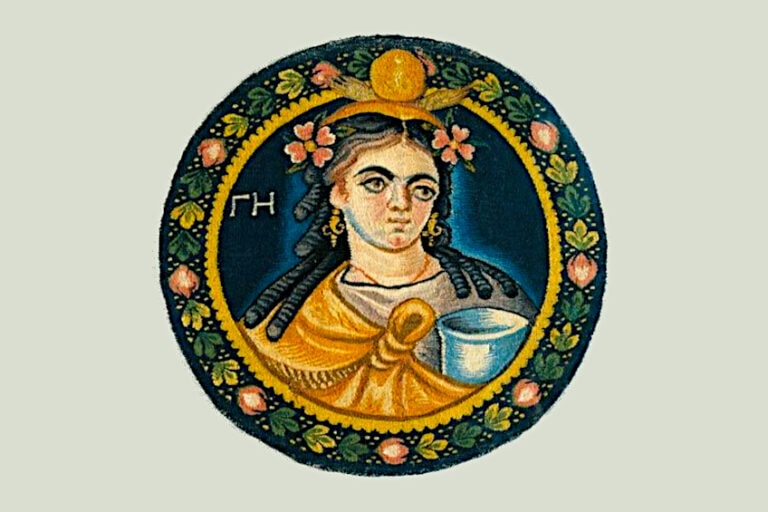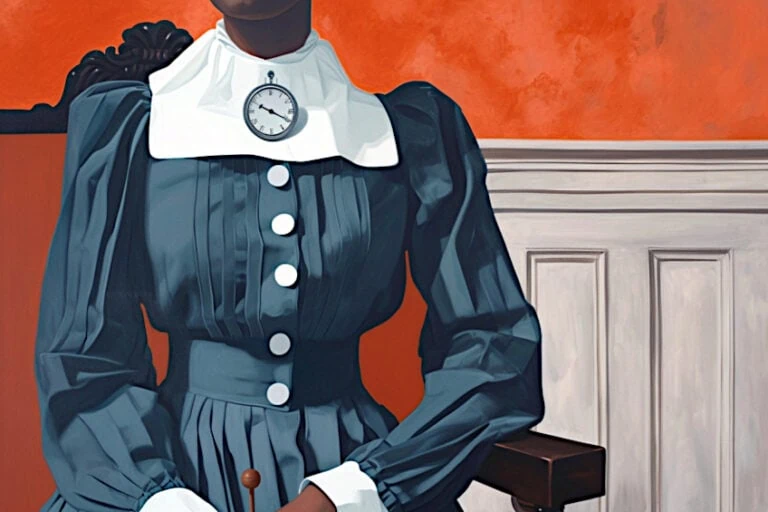Greek God Hypnos – The Personification of Sleep and Oblivion
In the fascinating realm of Greek mythology, not all gods possessed the same human-like qualities as the Olympian gods. Instead, many served as personifications of specific fundamental forces and ideas. Hypnos was one of the children of the primordial gods and was regarded as the personification of sleep. The Greek god Hypnos not only represented specific aspects of human existence, such as sleep, but also of oblivion. Let’s find out more about Hypnos’ facts, Hypnos’ symbols, and the myths associated with him, such as the story of Hypnos and Thanatos.
The Mythology of the Greek God Hypnos
| Name | Hypnos |
| Gender | Male |
| Symbols | Poppy, Cottonwood, and River Lethe |
| Personality | Calm and gentle |
| Domains | Sleep and oblivion |
| Parents | Nyx or Astraea and Erebus |
| Spouse | Charis Pasithea |
According to Hesiod’s poem the Theogony, the Greek god of sleep was one of the many offspring of Nyx, who was a primordial goddess who represented the night. She was a terrifying and formidable goddess. There are a few different accounts concerning the origins of Hypnos. According to certain versions of the tale, he was Nyx’s fatherless son.
 Night and Sleep by Evelyn de Morgan (1878); Evelyn De Morgan, Public domain, via Wikimedia Commons
Night and Sleep by Evelyn de Morgan (1878); Evelyn De Morgan, Public domain, via Wikimedia Commons
According to some accounts, he was the son of Erebus and Nyx. Erebus was the personification of absolute darkness. Based on certain accounts by Seneca, though, Hypnos was believed to be the son of the enigmatic deity Astraea.
According to one legend told by the Roman grammarian Fronto, the god of Sleep known as Somnus in Rome had been created by Jupiter and had no true parents. Regardless of his lineage, most versions of the myth maintain that the Greek god Hypnos had a twin brother, Thanatos, the personification of death. The majority of scholars believe that Hypnos and Thanatos resided in the Underworld. More precisely, legend has it that he resided in the Erebus Valley, in a damp cave near the River Lethe.
Lethe was one of the underworld’s five rivers in Greek mythology, and its waters induced oblivion and memory loss.
 Dante and the River of Lethe by Gustavore Dore (1880); Gustave Dore, Public domain, via Wikimedia Commons
Dante and the River of Lethe by Gustavore Dore (1880); Gustave Dore, Public domain, via Wikimedia Commons
There was an ebony bed in Hypnos’ cave. Poppies and other sleep-inducing vegetation flourished at the entrance. No noise or light could enter the cave, enabling Hypnos to fall asleep. His residence was appropriate for his responsibilities, establishing his purpose and function within Greek mythology. Homer, an ancient Greek poet, provides another account of Hypnos’ living arrangement. Hypnos was believed to reside on the Aegean island of Lemnos in Homer’s Iliad. His island was very dreamlike and helped sustain his children’s lives.
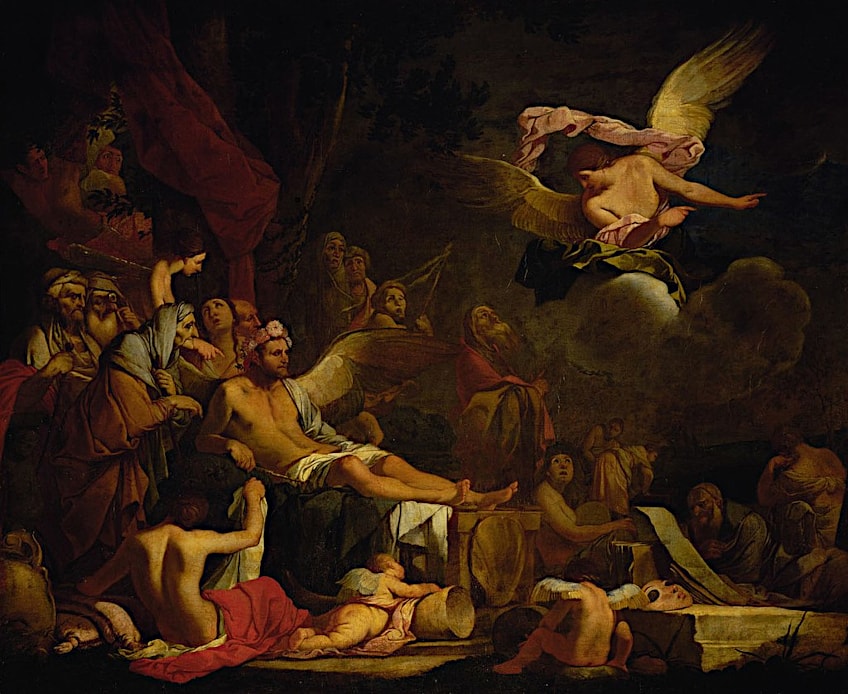 Iris Delivering a Message to the Kingdom of Hypnos by Giulio Carpioni (between c. 1655 and 1660); Giulio Carpioni, Public domain, via Wikimedia Commons
Iris Delivering a Message to the Kingdom of Hypnos by Giulio Carpioni (between c. 1655 and 1660); Giulio Carpioni, Public domain, via Wikimedia Commons
The Children of the Greek God Hypnos
Hypnos, like many of the Greek gods, had offspring who helped him achieve his aims. Hypnos married Pasithea, one of the Greek Charities, who were also known as the Graces. Pasithea embodied meditation, relaxation, and hallucination, which made for an ideal partnership with Hypnos. In certain versions of the Hypnos tale, the two gods had several sons. They were referred to as the Oneiroi. These sons, according to Greek mythology, were the bringers of dreams.
Hypnos would put mankind to sleep, while the Oneiroi would bring a range of dreams.
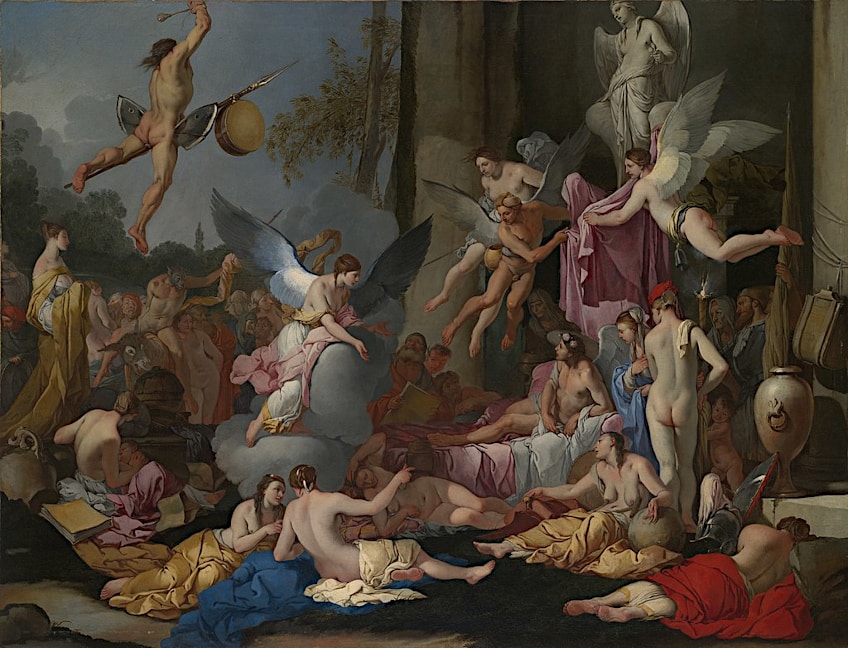 The Kingdom of Hypnos by Giulio Carpioni (between 1660 and 1665); Giulio Carpioni, Public domain, via Wikimedia Commons
The Kingdom of Hypnos by Giulio Carpioni (between 1660 and 1665); Giulio Carpioni, Public domain, via Wikimedia Commons
Morpheus, Phantasus, and Icelus were among the best known sons of Hypnos. Morpheus was responsible for dreams regarding humans, whereas Phantasus and Icelus delivered dreams about inanimate things and animals. One son was also the source of nightmares. He was known as Phobetor in Ovid’s Metamorphoses. However, whether or not the Oneiroi were Hypnos’ sons is debatable, depending on which version of the tale you read. The Oneiroi are Nyx’s sons and Hypnos’ siblings in the Theogony.
The Role of Hypnos
He was in charge of putting all living things to sleep, both human and immortal. As a result, he was considered as an exceptionally powerful divinity. According to Hesiod, he walked calmly across the land and the vast sea and was compassionate toward humanity. The deity would usually approach individuals from the air and could put them to sleep using an assortment of tools, including his wings, a twig, a wand bathed in the River Lethe’s waters, or a horn loaded with sleep-inducing medications.
 Fresco from Delos depicting Hypnos covering a sleeping woman with a curtain or veil; Zde, CC BY-SA 4.0, via Wikimedia Commons
Fresco from Delos depicting Hypnos covering a sleeping woman with a curtain or veil; Zde, CC BY-SA 4.0, via Wikimedia Commons
Hypnos could also put gods and humans to sleep by covering them with a curtain or simply being present. However, when he attended the wedding of Cadmus and Harmonia he intentionally left his wand at home to ensure that the couple would not spend their wedding night asleep.
Hypnos has a dual nature. On the one hand, he was a peaceful, benevolent force – the personification of pleasant sleep and a liberating force from stress and anxiety. On the other side, Hypnos was strongly associated with death – after all, Thanatos, the personification of death, was his twin brother – and could therefore be frightening. Furthermore, as the Greek god of sleep, Hypnos was often seen as a deceiving god. He was thought to be a Dionysian in some later versions. He was also regarded as Eros’s companion in some versions.
Attributes and Personality of the Greek God Hypnos
Hypnos was recognized for inducing peaceful rest and dreams that were pleasant. He employed a careful approach, utilizing his wings to discreetly and softly descend on individuals, enabling them to drop off to sleep. Hypnos was seen as a source of relief and refreshment, providing an escape from the anxieties and grief of the waking world. While Hypnos was primarily portrayed as a beneficent individual, he did have the capacity to deny sleep to those he thought unworthy and to utilize his skills to manipulate dreams in different ways.
 Hypnos (Dream) by Gyula Benczúr (1920); Gyula Benczúr, Public domain, via Wikimedia Commons
Hypnos (Dream) by Gyula Benczúr (1920); Gyula Benczúr, Public domain, via Wikimedia Commons
If offended or if it served the purposes of the gods, he was also able to produce nightmares or unpleasant visions.
Hypnos was strongly affiliated with the domain of darkness and the shift from being conscious to being asleep as the son of the goddess of night, and the brother of death personified. His peaceful mindset symbolized the required balance between the awake and sleeping phases. Though seldom shown as particularly active or forceful, Hypnos was held in high reverence and respect by the other gods. Even great deities like Zeus and Hera sought his assistance, as they understood the significance and role of sleep and dreams in the universe.
Physical Attributes and Depictions in Art
Hypnos is sometimes represented with wings on his temples or shoulders, illustrating his power to quickly descend on a person and put them to sleep. These wings signify his ethereal nature and his capacity to travel between the gods’ and mortals’ realms. Hypnos is often depicted grasping a poppy blossom or encircled by poppies. These blossoms were connected to sleep in Greek mythology and were known to have sedative effects, therefore they were an appropriate symbol for Hypnos.
 Roman statuette of Somnus/Hypnos with winged head, holding poppy seed heads in his left hand while pouring sleep from a horn in his right hand; Ad Meskens, CC BY-SA 3.0, via Wikimedia Commons
Roman statuette of Somnus/Hypnos with winged head, holding poppy seed heads in his left hand while pouring sleep from a horn in his right hand; Ad Meskens, CC BY-SA 3.0, via Wikimedia Commons
Hypnos is typically depicted with a serene and tranquil expression, which reflects his gentle and calming personality.
The Greek god Hypnos is often portrayed as a young deity, illustrating the concept that sleep rejuvenates. He tends to appear with an invigorated and serene visage, reflecting the state of renewal that sleep provides. Hypnos is depicted in flowing robes or clothing that drapes around his body. This lightweight clothing evokes the dreamy, intangible characteristics of sleeping. The Greek god Hypnos was also often represented alongside his brother Thanatos, particularly in early artwork.
An episode from the Iliad in which the two brothers carry the body of the dead hero Sarpedon back to his hometown in Lycia was a popular subject for Greek vase artists.
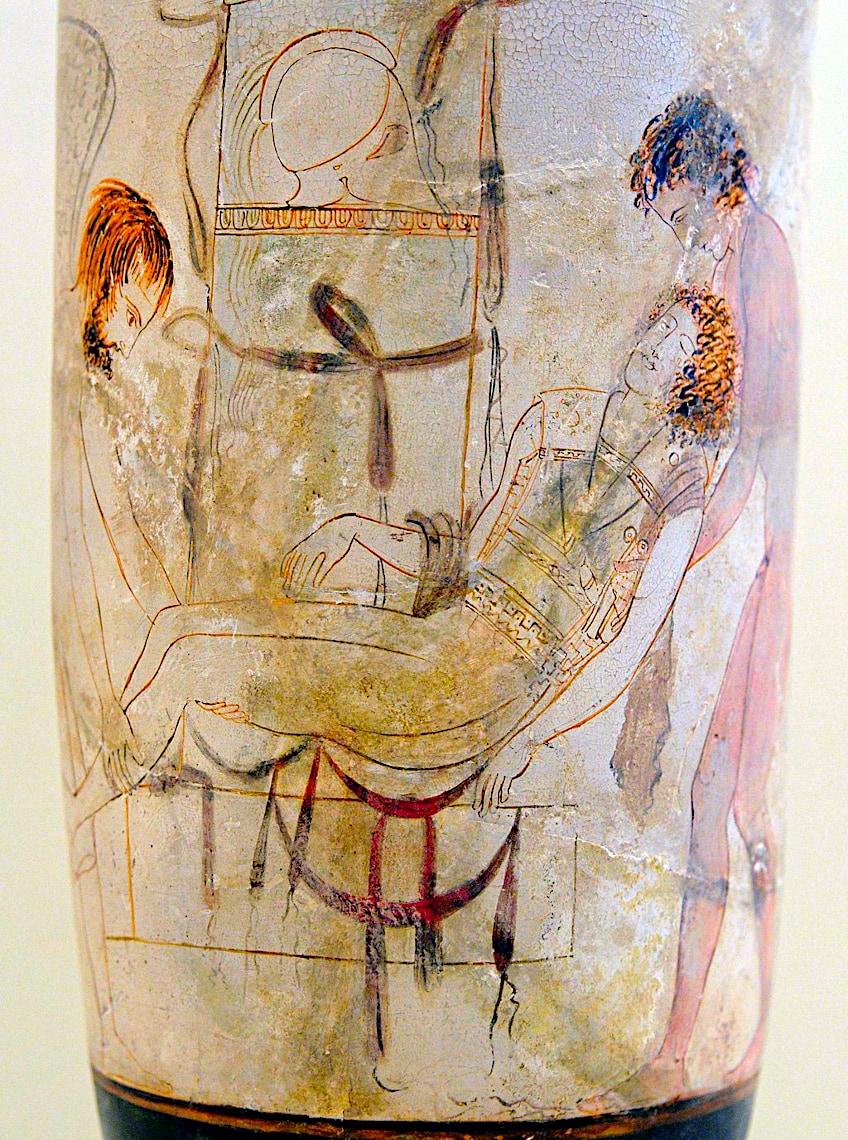 Attic white-ground lekythos showing Thanatos and Hypnos carrying Sarpedon’s body from the battlefield by the Thanatos Painter (c. 440 BCE); British Museum, CC BY 2.5, via Wikimedia Commons
Attic white-ground lekythos showing Thanatos and Hypnos carrying Sarpedon’s body from the battlefield by the Thanatos Painter (c. 440 BCE); British Museum, CC BY 2.5, via Wikimedia Commons
Thanatos and Hypnos statues were also featured in ancient Sparta’s citadel. They were represented as children in Nyx’s arms on the famed Cypselus Chest. He was regularly depicted with healing gods like Hygieia and Asclepius. There was a sculpture of Hypnos lulling a lion to sleep in an Asclepius temple near Sicyon. The scene where the god Dionysus finds Ariadne who has been sent to sleep by Hypnos was also a favorite topic in ancient art.
A bronze head of the Greek god of sleep, currently housed in the British Museum in London, is one of the most renowned works of art portraying Hypnos. Wings emerge from his temples, and his hair is intricately arranged, some strands tied in knots and others hanging freely from his head.
 Bronze head of Hypnos (1st – 2nd Century CE); Carole Raddato from FRANKFURT, Germany, CC BY-SA 2.0, via Wikimedia Commons
Bronze head of Hypnos (1st – 2nd Century CE); Carole Raddato from FRANKFURT, Germany, CC BY-SA 2.0, via Wikimedia Commons
Hypnos in Greek Mythology
While the Greek god of sleep is a lesser-known deity in Greek mythology, he was well-liked by the ancient Greeks. He was regarded as a peaceful and calm deity. Mortals did not fear him, and instead, they felt they owed the god half their lives because of their need for sleeping and dreaming. Let us find out what role he played in the Iliad.
Hypnos and Zeus
Hypnos utilized his abilities to deceive Zeus in one tale. Zeus had promised the sea-goddess Thetis, mother of Achilles, that he would make the Greeks regret their disrespectful behavior towards her son by making them lose to the Trojans during his absence from the battlefield. Hera was enraged by this and devised a scheme to tip the scales back in favor of the Greeks. Hera summoned the goddess of love, Aphrodite, and requested a talisman that would assure the success of her deception. However, in order to obtain the talisman, she had to lie to Aphrodite who favored the Trojans. She explained to Aphrodite that she needed a talisman to stop herself and Zeus from fighting. Aphrodite eventually consented to Hera’s request.
Hera was nearly ready to deceive Zeus, but she required the assistance of Hypnos, who had previously helped her when she wanted to punish Herakles behind his divine father’s back.
Hera summoned Hypnos and urged him to assist her by putting Zeus to sleep. Hypnos was hesitant since the previous time he put the deity to sleep, Zeus awakened enraged and embarked on a rampage in search of Hypnos. Hypnos avoided Zeus by hiding in the home of his mother, Nyx. This made Hypnos hesitant to accept Hera’s proposal and assist her in deceiving Zeus on this occasion too. Hera initially presented him with a stunning golden throne that would never break apart and a footstool to match.
 Bell-krater with a depiction of Hera conspiring with Hypnos while Europa pleads with Zeus to spare the life of Sarpedon (c. 400-380 BCE); Metropolitan Museum of Art, CC0, via Wikimedia Commons
Bell-krater with a depiction of Hera conspiring with Hypnos while Europa pleads with Zeus to spare the life of Sarpedon (c. 400-380 BCE); Metropolitan Museum of Art, CC0, via Wikimedia Commons
Hypnos turned down the initial offer, but Hera ultimately persuaded him with the promise that he could marry Pasithea, one of the younger Graces. Hypnos had made vows by the river Styx and summoned the gods of the underworld as witnesses in order to assure that he married Pasithea.
Hera went to visit Zeus atop Mount Ida’s highest summit, Gargarus. Zeus was enamored with her and detected nothing while Hypnos was cloaked in a dense mist and hiding behind a pine tree. Hera told Zeus the same lies she had told Aphrodite when he questioned what she was doing there and why she had come from Olympus. She told him she was going to try to help her parents to stop fighting, but she paused to consult him since she didn’t want to leave without him knowing and have him be unhappy with her when he eventually found out. Zeus stated she could come whenever she wanted and that she should put off her visit and remain with him so they could take pleasure in each other’s company. Zeus informed her that he had never loved someone as much as he did her at the time.
With Hera in his arms, he embraced her and Hypnos then subsequently put him to sleep.
While this was going on, Hypnos went to the Achaeans’ ships to inform Poseidon that he was able to assist the Greeks by providing them victory as Zeus was still deeply sleeping. Hypnos exits the legend here. The fight shifted in favor of the Greeks as a result of Hypnos’ assistance in fooling Zeus, and Zeus never found out that Hypnos had deceived him again.
Hypnos and Endymion
Endymion was an attractive mortal shepherd who caught the eye of Selene, the moon goddess in this myth. Selene fell in love with Endymion and asked Zeus for a favor. She begged Zeus to provide Endymion with perpetual sleep and endless youth so she could see him every night without ever getting old or waking up. Endymion fell into a perpetual slumber on Mount Latmos after Zeus granted Selene’s wishes. Selene descended from the sky each night to be with Endymion, looking at his sleeping body and showering her love on him.
Hypnos enters the story at this point was in charge of initiating and sustaining Endymion’s eternal sleep.
 Detail of a sarcophagus showing Hypnos pouring sleep from a horn onto Endymion while Selene looks on (early 3rd Century CE); Louvre Museum, CC BY 3.0, via Wikimedia Commons
Detail of a sarcophagus showing Hypnos pouring sleep from a horn onto Endymion while Selene looks on (early 3rd Century CE); Louvre Museum, CC BY 3.0, via Wikimedia Commons
Hypnos kept Endymion in a perpetual state of sleep, which enabled Selene to visit him without disturbing him or waking him up. The myth’s inclusion of Hypnos emphasizes his function as a facilitator of sleep and dreams in Greek mythology. He contributed to the continuation of Selene’s love affair with Endymion by keeping Endymion perpetually sleeping without being influenced by the passage of time. Endymion’s tale represents the eternal and unattainable nature of idealistic love. It romanticizes the idea of perpetual sleep, in which Endymion’s beauty has been frozen in time, permanently captivating Selene.
In some versions of the myth it was Hypnos himself who fell in love with Endymion and had him sleep with his eyes open so that he could gaze into his lover’s eyes all the time.
Hypnos and Dionysus
There were also more serious and darker myths about Hypnos assisting Dionysus with some of his sexual endeavors such as lulling gorgeous nymphs to sleep so Dionysus was able to sneak up on the nymphs and rape them. He first did this to the nymph Nicaea, and then afterward to the nymph Aura.
Aura had made the mistake of questioning Artemis’ virginity, claiming that the goddess was too curvaceous to be a virgin. Artemis intended to punish Aura by taking away her precious virginity.
She enlisted the assistance of Nemesis, the goddess of vengeance, and the god of love, Eros, who made Dionysus fall madly in love with Aura. While Dionysus was stalking the virgin nymph, Hypnos lulled her to sleep.
 Fresco from Pompeii depicting Dionysus discovering Ariadne asleep with Hypnos at her side (1st Century CE); Sailko, CC BY-SA 3.0, via Wikimedia Commons
Fresco from Pompeii depicting Dionysus discovering Ariadne asleep with Hypnos at her side (1st Century CE); Sailko, CC BY-SA 3.0, via Wikimedia Commons
Hypnos and Thanatos
During the Trojan War, an important incident involving Hypnos and his brother, Thanatos, is recounted in Homer’s poem, the Iliad. Many of the gods had sons who fought in this war. Zeus noticed his son Sarpedon’s plight on the battlefield during a critical juncture in the Trojan War when Sarpedon was engaged in combat against the hero Patroclus. This occurred during a juncture when Zeus had decreed that Patroclus should be momentarily victorious, before his ultimate demise at the hands of Hector.
Zeus sympathized with his son’s situation and considered saving him. However, Hera warned him that if he were to prevent Sarpedon from dying, all the other gods would want their sons to be spared death as well, and the natural order of things would be disrupted.
Zeus instructed Thanatos and Hypnos to carry Sarpedon’s body away from the battlefield to Lycia, so that he could be buried in his homeland.
 Krater showing Hypnos and Thanatos directed by Hermes to carry the Body of Sarpedon to Lycia by Euxithéos (potter) and Euphrenios (painter) (c. 515 BCE); Jaime Ardiles-Arce (photographer). Krater by Euphronios (painter) and Euxitheos (potter)., Public domain, via Wikimedia Commons
Krater showing Hypnos and Thanatos directed by Hermes to carry the Body of Sarpedon to Lycia by Euxithéos (potter) and Euphrenios (painter) (c. 515 BCE); Jaime Ardiles-Arce (photographer). Krater by Euphronios (painter) and Euxitheos (potter)., Public domain, via Wikimedia Commons
Hypnos and the Indians
In Nonnus’ epic poem, the Dionysiaca, Hypnos assists the Indians in their battle against the child Dionysus. In one episode, the Indians, headed by their monarch Deriades, revolted against Dionysus, who was portrayed as a young and strong divinity. The Indians attempted to defy and overthrow Dionysus because he represented a threat to their territory and customs. Recognizing Dionysus’ strength as well as his divine abilities, the Indians sought aid from the gods.
Their cries were heard by Hera, who sympathized with their plight. Hera decided to help the Indians and enlisted the help of Hypnos.
Under Hera’s direction, Hypnos entered the conflict by momentarily knocking Dionysus out with his sleep-inducing skills. Hypnos lessened Dionysus’ heavenly influence and reduced his influence on the battlefield by lulling him to sleep. The Indians took the upper hand in the conflict while Dionysus was briefly immobilized. They launched powerful strikes and advanced on Dionysus’ supporters, certain that they could vanquish him. However, the centaur Chiron, Dionysus’ companion, and tutor, stepped in.
 Mosaic depicting the Conquest of India by Dionysus (c. 200 – 300 CE); Jona Lendering, CC0, via Wikimedia Commons
Mosaic depicting the Conquest of India by Dionysus (c. 200 – 300 CE); Jona Lendering, CC0, via Wikimedia Commons
Chiron recognized the threat that Hypnos’ involvement posed and managed to rouse Dionysus from his slumber. Dionysus, now rejuvenated from his sleep, resumed his task and quickly shifted the course of the war. In the subsequent conflict, Dionysus defeated the Indians and triumphed. The intervention of Hypnos ultimately failed to prevent Dionysus’ influence, since he is a deity who embodies the forces of life, fertility, and ecstasy.
Hypnos in Western Psychology
The term “hypnosis” first appeared in psychology in the late 18th century, established by a Scottish pioneer in the study of hypnosis, James Braid. The phrase was derived from the Greek word “hypnos”, but it particularly refers to the state of centered relaxation and heightened suggestibility achieved during hypnosis.
Hypnosis is a condition of altered consciousness characterized by enhanced suggestibility, focused concentration, and heightened relaxation.
 Man Hypnotizing a Woman using the animal Magnetism Method engraving after D. Dodd (1802); See page for author, CC BY 4.0, via Wikimedia Commons
Man Hypnotizing a Woman using the animal Magnetism Method engraving after D. Dodd (1802); See page for author, CC BY 4.0, via Wikimedia Commons
It has been used as a form of treatment to assist people in accessing and processing subconscious ideas, emotions, and memories. In the field of psychology, hypnosis has been used to induce relaxation, manage pain, relieve anxiety and phobias, conquer addictions, and address a variety of mental and behavioral issues. It is usually carried out by a skilled expert, such as a hypnotherapist or a certified psychologist, who guides the subject into a trance-like condition using verbal instructions and images.
Legacy
Hypnos, the Greek god of sleep, has a strong presence and impact in contemporary society and media. His demeanor and associations with sleep and dreams have struck a chord with audiences, leading to his incorporation in a wide range of popular depictions. Hypnos occurs as both a character and an idea in various works of literature.
Authors sometimes use his mythological qualities to create evocative and surreal settings or to delve into the realm of dreams and the unconscious mind.
 Depiction of Morpheus from Neil Gaiman’s The Sandman by Álvaro Fernández González (2023); Álvaro Fernández G, CC BY-SA 4.0, via Wikimedia Commons
Depiction of Morpheus from Neil Gaiman’s The Sandman by Álvaro Fernández González (2023); Álvaro Fernández G, CC BY-SA 4.0, via Wikimedia Commons
Hypnos has appeared in fantasy novels, notably Neil Gaiman’s Sandman series, as a member of the Endless, a group of omnipotent creatures that embody various aspects of existence. Hypnos has made an appearance as a minor character or as a representative of sleep-related powers in a number of games. He appears in games such as God of War, where he assists the protagonist in exploring dreamscapes.
In this article, we explored all the Hypnos facts that you might find interesting, such as Hypnos’ symbols within Greek mythology. As we have discovered, this renowned figure was regarded as the Greek god of sleep and was often called upon by mortals and gods alike to make use of his powers. In antiquity, Hypnos did not have a significant cult. He did, however, enjoy considerable devotion in Troezen, Peloponnese, where there was an altar constructed in devotion to him and the Muses. Hypnos sculptures were also found in Sparta and Sicyon, possibly accompanied by cult and religious honors. Yet, despite not being a widely worshiped figure, he was still revered by many due to playing such a large part in people’s daily lives.
Frequently Asked Questions
What Was Hypnos the God of in Greek Mythology?
In the ancient mythology of the Greeks, Hypnos was referred to as the Greek god of sleep. He was often called upon by mortals and gods to assist them using his powers. His offspring were responsible for providing people with dreams and nightmares. His twin brother was Death (Thanatos).
What Were Hypnos’ Symbols?
The most well-known symbol linked with the Greek god Hypnos is the poppy flower. Poppies were connected with sleep because they were known to have sedative effects. Hypnos is often shown with wings on his temples, shoulders, or his back. These wings signify his ability to stealthily and quickly fall upon someone and put them to sleep. The wings also represent his link to the realms of both mortals and deities, as well as his capacity to travel between them. In some portrayals, Hypnos is represented with a wand or staff, which is associated with his ability to induce sleep. The wand is often decorated with poppy flowers or a ribbon, which represents the binding and relaxing aspect of sleep. These symbols depict Hypnos’ role as the Greek god of sleep, as well as his abilities to induce and govern sleep.

I am deeply passionate about history and am constantly fascinated by the rich and complex stories of the past. As the editor-in-chief of learning-history.com, I have the opportunity to share this passion with a wide audience through the creation and distribution of engaging and informative content about historical events, persons, and cultures. Whether it’s through writing articles and blog posts or creating videos or podcasts, I strive to bring the past to life in a way that is both accurate and enjoyable. My expertise in history, combined with my strong writing and communication skills, allows me to effectively communicate complex historical concepts and make them accessible and interesting to a wide range of readers. I am truly grateful for the opportunity to share my love of history with others through my work on learning-history.com.



